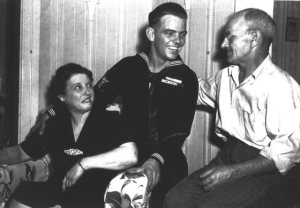By Mark DePue
Life during the Great Depression was not easy for Bill Ingram, the son of a poor Springfield, Ill., coal miner.
“He’d come home, all you’d see is his eyes,” recalls Bill today. “The rest of him was all covered over with the coal dust. There was five of us [kids] in my family. Dad called us the hungry five.”
At age 14, Ingram was expelled from school for what today would be a frivolous offense. His options were few, but Bill knew what he wanted. He enthusiastically enlisted in the Navy on his 17th birthday in June 1941.
He thrived on the rigorous training at Great Lakes, and was proud when the Navy assigned him to the USS Houston, a heavy cruiser then sailing the seas west of the Philippine Islands.
On December 7th Ingram was somewhere west of the Hawaiian Islands steaming toward Australia where he was to join up with the USS Houston crew. Once on board, he instantly became the greenest and youngest member of a crew of old salts and experienced hands. Within days the Houston was back at sea as part of a small naval task force.
While patrolling the Java Sea on February 27th, 1942, the task force encountered a Japanese invasion fleet. It was an uneven fight, and one day later, just after midnight, the USS Houston was hit by torpedoes and naval gunfire. The ship was listing heavily when word went out to abandon ship; Ingram jumped into the water about 3 a.m.
“When I hit that water, I started to swim,” he recalls. He swam as hard and as long as he could to avoid being sucked down with the ship, then found himself alone in a vast ocean as he watched his ship slip under the waves. “I was in that water all night long by myself, in the dark, from three o’clock in the morning until three or four o’clock the next afternoon.”
Ingram’s troubles were just beginning. He was picked up by a Japanese patrol boat, then transferred to a larger ship, but no other Americans were on board. Soon a Japanese officer began an interrogation. “You are a baby,” the officer began. After each question Ingram answered “I don’t know; I don’t know that,” and he spoke the truth.
“Every time that he asked me a question, there was a sailor standing behind me; he had his fist rolled up and he’d hit me with the inside of his fist right on the ear. … I couldn’t hardly hear what was going on after about five minutes,” Ingram said.
When they finally decided that Ingram indeed did not know anything, they tossed a life ring into the water, then threw Ingram in after it. He swam away from the screws, then realized they were using him for target practice. Once again he swam for his life.
Ingram’s luck finally improved. He was picked up by a small group of Houston sailors who had commandeered a native fishing boat. The group eventually made it to land, and headed for a building flying a Red Cross flag where Javanese natives gave them some food and clothing, then “they put us in a cell. It was a jail. It wasn’t a hospital, it was a jail!”
It wasn’t long before Japanese soldiers arrived and took the small party of Houston sailors captive.
Of the USS Houston’s original crew of 1,061 men, 368 survived, and most of them, including Ingram, spent the rest of their war working in the hellish jungles of Burma constructing the Burma railroad, which the prisoners derisively called the “Death Railway.” The name was all too fitting, with over 12,000 Allied prisoners of war dying during its construction.
Ingram survived that ordeal, but by 1945 his health gave out. He came down with a serious case of malaria, and cannot remember his liberation or his trip through Calcutta to New York City. He gained his senses once in America, took the train to Illinois, and surprised his mother when he arrived on her doorstep in Springfield.
“The happiest day of our lives,” his mother wrote on a snapshot taken that day. “Our second son Billy had arrived home after three years and eight months in a Japanese Prison Camp.”
Bill Ingram made the Navy his life after the war, retiring in 1961 as a Chief Petty Officer. He suffered unimaginable cruelties during his captivity, but endured it all with his spirit intact. He now lives in Jacksonville, Fla., close to the ocean he loves.
Mark DePue is the Director of Oral History at the Abraham Lincoln Presidential Library and Museum. You can listen to Bill Ingram’s entire story and many others in the “Veterans Remember” section of the program’s website, www.oralhistory.illinois.gov.




